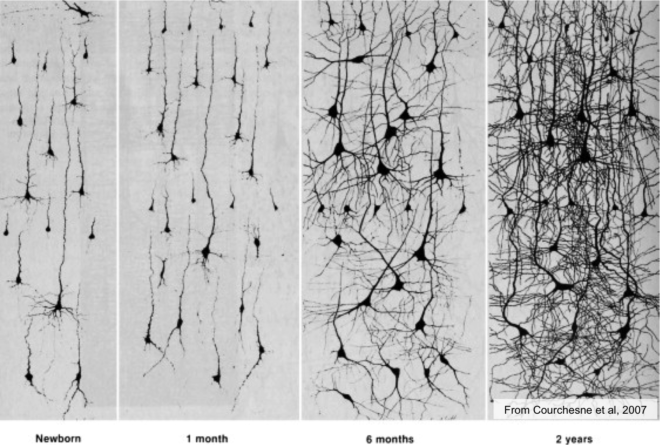The complex web of dendrites mediating information flow in the brain may be a key driver of human intelligence.
In 1887, a Spanish man went to work in his kitchen. He was not making tortilla espanola, croquettes or pista. In fact, he was not making any sort of Spanish culinary delight. Neither was he cooking a dish of English or French origins. Santiago Ramón y Cajal was staining brains.
The method he used – Golgi staining – had been developed by an Italian scientist some years earlier. It involved reacting silver nitrate with hardened brain tissue. The results were stunning: neurons were stained in their entirety, their spindly structures visible to the world. Stunning wasn’t good enough for Cajal’s purposes. He required magnificent. He double-stained his sample and peered through his microscope. Magnificent had been achieved. Pencil touched paper and the results were meticulously documented for all to see.
Based on his drawings, Cajal formulated the beginnings of the Neuron Doctrine, proving that neurons were discrete individual cells composed of dendrites, an axon, and the cell body. Information, he posited, travels from the dendrites, through the body cell, and into the axon. This is still our understanding of how neurons work today, though we’ve made many discoveries since then.
Chief among them is the importance of dendrites to human intelligence. In 2001, researchers from the University of Queensland in Australia and Instituto Cajal in Spain examined neurons in the prefrontal cortex of humans, comparing them to the same neurons in macaque and marmoset monkeys. They wanted to understand why human beings are better at processing and understanding complex information than more primitive animals. In other words, why can you and I do mathematics and write poetry with multiple layers of understanding, when primates cannot?
They discovered that the dendrites in our brains are more complex than those that connect through the minds of our furry cousins. The human dendrites were both more branched and more spinous than the dendrites in monkey brains studied, suggesting that the secret to our relative intelligence lies, at least in part, with these tiny brain cell structures.
These findings add nicely to the literature of intelligence and brain structure that scientists have been arduously building since Cajal first double stained his seminal brains. In the 1970s, nearly a hundred years after Cajal’s research led to the development of the Neuron Doctrine, Dr. Peter R Huttenlocher set out to explain mental retardation.
The regular battery of neurological tests had failed him. 15 percent of the disabled brains he studied using standard gross anatomical and microscopic techniques appeared no different from a normal brain. An even greater percentage showed only minor signs of difference. Brain weight might be slightly below average, or the cortical layers might be poorly differentiated. It wasn’t enough to explain the human results: severe mental disability.
Huttenlocher was not one to give up. If traditional anatomy would not reveal with answer, he was going to dig deeper. He was going to look smaller. Though the existing literature was sparse at that time, it indicated that the very structure of neurons was vulnerable early in life. Smaller than normal axons had been observed in children who suffered from postnatal malnutrition. Dendrite growth had declined in subjects who had been deprived of visual stimulation post birth. Could it be, he wondered, that cognitive disability is a result of abnormalities in these structures?
He set to work, using the Golgi staining method to identify dendrite abnormalities in post mortem brains of the severely mentally retarded. He looked at both dendrite growth and spatial arrangement in neurons from the middle frontal gyrus. He was not disappointed. Though the relationship between dendrite abnormalities and retardation was not clear in his examination of adult brains, all six of the severely retarded children studied exhibited notable abnormalities in dendrite length, spatial arrangement or both. Something was certainly going on with these kids’ dendrites.
From a theoretical perspective, this makes a lot of sense. Dendrites relay information in the brain, and the transfer and connections of information are what allow people to think and reason. If the dendrite length is shorter than average, or contains less robust branching, this will surely impact how information can flow and be processed. What is mental retardation other than the relative inability to understand and process information?
Today, as researchers, practitioners and patients become interested in the promises of individualized medicine, our understanding of dendrite variation is increasingly important. If substantial variation exists between humans and apes, and even relatively minor variation can cause mental retardation, what might the miniscule variables between each person’s brain structure tell us? As we learn more about the minute details that make us who we are, we may also learn more about how to best stimulate and heal our individual brains.
Read also A Changing Brain is a Normal Brain


















